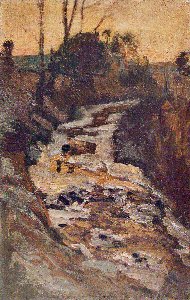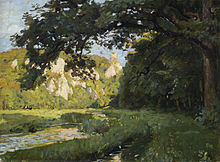Otto Reiniger
Otto Reiniger (* 27. February 1863 in Stuttgart , † 24. July 1909 on the estate Tachensee in Weilimdorf (today Stuttgart)) was a German landscape painter of Impressionism .
Life

Reiniger first studied in Stuttgart at the State Academy of Fine Arts with Jakob Grünenwald and Albert Kappis , then switched to the Academy of Fine Arts in Munich from January to April in 1883 and took lessons with Joseph Wenglein . In the same year he stayed in central Italian Olevano Romano (June to November) and in the following years he made several study trips to Italy. In his monograph The German Art Academies in the 19th Century: Artist Training Between Tradition and Avant-Garde , Ekkehard Mai writes about Reiniger's apprenticeship years: "The history and genre painter Jakob Grünenwald, also trained in Munich, Friedrich Keller, Albert Kappis and Adolf von Donndorf gave Stuttgart art in the ninth decade [of the 19th century] the direction. Obviously not enough, because Munich was still more the travel destination, if you consider the apprenticeship periods of Haug, Otto Reiniger and Hermann Pleuer. "
In 1888 he returned to Stuttgart and settled there. In 1883 he married Marie Schraudolph (1867–1951), daughter of the painter and professor at the Stuttgart Art Academy Claudius Schraudolph the Younger (1843–1902). In 1906, Reiniger moved to an estate on Lake Tachensee , which lies between the then still independent communities of Korntal and Weil im Dorf . Two years earlier, a large part of his works had been destroyed in a fire in his Stuttgart studio.
Reiniger was the uncle and godfather of the painter Helene Wagner. The painter, born in Stuttgart on April 23, 1878, was a student of Prof. Christian Landenberger (himself an impressionist painter). She lived and worked in Stuttgart until her death on September 16, 1956, and created landscapes, still lifes, portraits - especially portraits of children - as subjects. The artist remained unmarried.
Otto Reiniger was a member of the German Association of Artists .
Awards and honors
In 1900, Reiniger was awarded the title of professor, but he did not hold a teaching position. One street in Stuttgart bears the name of Otto Reiniger. There is also an Otto Reiniger Weg in Ostfildern near Stuttgart.
Theodor Heuss , the first Federal President of the Federal Republic of Germany from 1949 to 1959 , wrote in a letter dated February 4, 1947 to the SPD politician Fritz Ulrich : "If names are supposed to come from the arts, then you can use the great Württemberg ] Painters like Otto Reiniger, Hermann Pleuer , Friedrich Keller (...) choose (...) "
Artistic creation
Otto Reiniger is one of the most important representatives of so-called Swabian Impressionism. He was even characterized as "the leading landscape painter among the Swabian Impressionists" (Professor Ingobert Schmid). The Stuttgart teacher Reiniger Albert Kappis is considered to be the pioneer of this school . On Swabian Impressionism, a presentation by the Kunstmuseum Stuttgart states: "In all regions of Europe, the Impressionists' open-air painting was taken up and adapted around 1900. Swabian Impressionism does not form a fixed group; rather, it unites artists who develop strong cultural impulses very independently France. Hermann Pleuer took up a typical Impressionist motif with his train station pictures: the modern city. Otto Reiniger painted the landscape around Stuttgart as an idyll permeated with light. And Christian Landenberger , who taught as a professor at the Stuttgart Academy, developed from the Munich Painting has its own circle of motifs. Its influence can still be felt in Oskar Schlemmer or Otto Meyer-Amden , both of whom studied at the Stuttgart Academy. " Reiniger also belonged to the Munich Secession .
Reiniger attracted the attention of contemporary artists, critics and gallery owners early on, including Max Liebermann and Paul Cassirer . Otto Reiniger owes the spread of his work to a wider public not least to the support of the patron Franz Freiherr von Koenig Fachsenfeld . He mainly created paintings from his Swabian homeland, in particular stream and river landscapes in different lighting moods.
In the article quoted above, Ingobert Schmid wrote about the development and extraordinary effect of Reiniger's work: "Even when he first appeared in Munich, he was noticed as one of the progressive ones. During studies at the“ Feuerbach ”, his favorite topic in the early 1990s, Reiniger develops his painting style with a lively ductus and a subdued coloring of its own. With extremely fine gradations of tones and a rough surface structure created with a bristle brush, he achieves extremely attractive effects. The timbre of his palette - the timbre of his voice, so to speak - makes Reiniger unmistakable. Reiniger was undisputedly the unsurpassed master of the reproduction of flowing water. At the turn of the century Reiniger's work heralded a change, probably stimulated by his encounter with pictures by French impressionists, which were first shown in Stuttgart in 1901 in the Württembergischer Kunstverein and then in 1904 in the Museum für Bildende Ku nst (today the State Gallery) were exhibited. After Reiniger had previously preferred the close-up type, the view is now widened and the dull timbre is replaced by a brighter luminosity of the color. The study “Neckar bei Hofen” is an impressive example of this. Reiniger's numerous admirers included the painter Hans Molfenter (1884–1979), who considered Reiniger to be the painter with the greatest feeling for nature.
Although Otto Reiniger, who had been awarded the title of professor in 1900, did not hold a teaching position, he was trend-setting for a whole generation of Swabian landscape painters, such as Karl Schickhardt (1866-1933) and Erwin Starker (1872-1938, who were represented in the Murrhardt exhibition) ). Also among the early works of the young academy student Maria Caspar-Filser and those of Willi Baumeister there are pictures 'in the manner of Otto Reiniger'.
On the 100th anniversary of Reiniger's death, an exhibition of his complete works was organized from October 18 to December 13, 2009 in Schloss Fachsenfeld in Aalen .
From March 9th to 25th, 2012 an exhibition took place in the Korntal Citizens' Meeting and from April 29th to May 20th 2012 in the Heimatmuseum Münchingen with the title “Painting in the Strohgäu 1900-1960. From Otto Reiniger to Sepp Vees ”. A press release on the exhibition stated: "The focus of the presentation is on the works of Otto Reiniger (1863–1909), one of the most important German impressionist landscape painters. His pictures are of supraregional importance. He settled in 1905 on the estate on the Tachensee near Korntal. In his successor, other artists such as Erwin Starker, Hermann Umgelter and Franz Heinrich Gref also moved to the Strohgäu. "
Collections
- Kunstmuseum Stuttgart - Gallery of the City of Stuttgart, Stuttgart. The history of the origins of the municipal collection is already linked to Reiniger's work. This begins in 1924 with the foundation of the private collection of Marchese Silvio della Valle di Casanova, which consisted of works by the Stuttgart impressionists Hermann Pleuer, Otto Reiniger and Christian Landenberger.
- Fachsenfeld Castle , Aalen
- Museum Nuss , Weinstadt-Stümpfelbach
- City of Korntal-Münchingen , Münchingen local history museum
literature
- Hans Klaiber: Otto Reiniger in memory . In: Württemberg. Monthly in the service of people and homeland, 1935, pp. 112–117.
- Contemporary art in Stuttgart , edited by v. Julius Baum, Stuttgart: Deutsche Verlags-Anstalt, 1913, 310 pp.
- Otto Reiniger Landscapes. With an accompanying word from Dr. Erich Heyfelder, 4 nn. S., 8 colored panels after paintings by Otto Reiniger, designed portfolio, Stuttgart, JFSteinkopf, no year (around 1924) [The panels show: Rhine near Laufenburg, Lake Thun, Gebirgsee (Murgsee), In the Modern Valley, olives on Lake Garda, Evening on Lake Garda, On Sirmione on Lake Garda, German Forest (Palatinate)]
- Isabel Grüner: Impressionism in the German Southwest. Otto Reiniger, Hermann Pleuer, Heinrich von Zügel, Christian Landenberger. Hohenkarpfen Art Foundation , Schwarzwald-Baar-Heuberg Art Association, Hausen ob Verena 1997, ISBN 3-93-056917-5
- Otto Reiniger 1863–1909 Catalog for the exhibition from May 4th-8th. June 1980. Museum Biberach, Biberacher Verlagsdruckerei, 1980, 27 pp.
- Ingobert Schmid: The landscape painter Otto Reiniger . Theiss, Stuttgart 1982, ISBN 3-8062-0297-4 (monograph with catalog raisonné)
- Hamburg views - painters see the city, Hamburger Kunsthalle, Wienand Verlag, p. 195
- Registration documents (PMB) Claudius Schraudolph, Munich, City Archives
- Ingobert Schmid, Otto Reiniger 1863 - 1909. Impressionism at the Tachensee (PDF file; 1.19 MB), in: Weilimdorfer Heimatblatt 31 / July 2009, pp. 1–11
- Gallery of the City of Stuttgart [Ed.], Hermann Pleuer. 1863 - 1911. Otto Reiniger. 1863 - 1909. Paintings, drawings. [Exhibition] Jan. 25 - March 1. 1964, Gallery of the City of Stuttgart. [Exhibition catalog], Stuttgart, self-published 1964
Web links
- Literature by and about Otto Reiniger in the catalog of the German National Library
- Permanent exhibition on Swabian Impressionism in Schloss Fachsenfeld
- Swabian Impressionism and Paths to Abstraction Exhibition reviews
Individual evidence
- ^ Ekkehard Mai, The German Art Academies in the 19th Century: Artist Training Between Tradition and Avantgarde , Cologne a. a .: Böhlau, 2010, p. 343
- ↑ Hamburg Views - Painters See the City, Hamburger Kunsthalle, Wienand Verlag, p. 192
- ↑ The donation: HELENE WAGNER, student of Prof. Christian Landenberger - An artist portrait - paintings, watercolors, drawings, District Office Zollernalbkreis, April 22nd - June 4th 2010 ( page no longer available , search in web archives ) Info: The link was automatically saved as marked defective. Please check the link according to the instructions and then remove this notice. (PDF; 306 kB)
- ↑ kuenstlerbund.de: Full members of the German Association of Artists since it was founded in 1903 / Reiniger, Otto ( Memento of the original from March 4, 2016 in the Internet Archive ) Info: The archive link has been inserted automatically and has not yet been checked. Please check the original and archive link according to the instructions and then remove this notice. (accessed on December 16, 2015)
- ↑ Th. Heuss, Educator for Democracy, Letters 1945–1949, ed. v. EW Becker, Stuttgarter Ausgabe, Letters, Munich: Saur, 2007, p. 249
- ^ Professor Ingobert Schmid, Color of Human Skin. On the exhibition "Swabian Impressionism", which opens on Sunday (2) , in: Murrhardter Zeitung from April 13, 2011
- ↑ See Bühler, Andreas; Zimmermann, Gabriele; Grüner, Isabel: Albert Kappis: Trailblazer of Impressionism in Swabia . Catalog for the exhibition at the Kunsthaus Bühler, January 30–20. March 1999 and Hohenkarpfen Art Foundation, March 28–4. July 1999. Stuttgart: Kunsthaus Bühler; Hausen-Hohenkarpfen: Ed. Hohenkarpfen Art Foundation , 1999. ISBN 3-930569-19-1 ; Bühler, Andreas: Albert Kappis, from the Munich School to Swabian Impressionism . In: Weltkunst 70/6, Munich 2000, pp. 1079-1081.
- ↑ Swabian Impressionism
- ↑ German Biographical Encyclopedia , 2nd edition, ed. v. Rudolf Vierhaus, Saur, Vol. 8, 2007
- ↑ Exhibition: Impressions of Pure Nature - Otto Reiniger 1863-1909
- ↑ Press appointment for the new exhibition "Painting in the Strohgäu 1900-1960. From Otto Reiniger to Sepp Vees"
| personal data | |
|---|---|
| SURNAME | Cleaner, Otto |
| BRIEF DESCRIPTION | German impressionist landscape painter |
| DATE OF BIRTH | February 27, 1863 |
| PLACE OF BIRTH | Stuttgart |
| DATE OF DEATH | July 24, 1909 |
| Place of death | Korntal -Tachensee, Württemberg |




